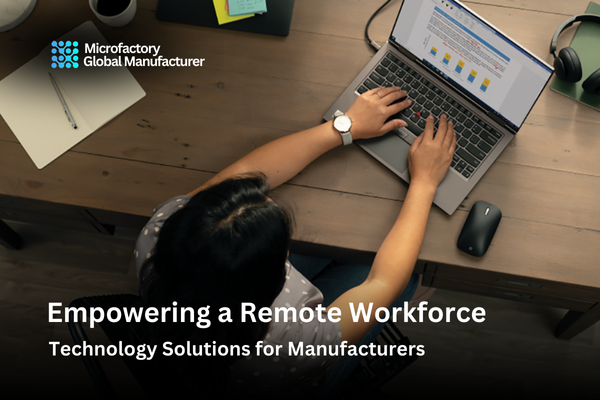In the dynamic landscape of modern manufacturing, the shift towards remote work has been both a challenge and an opportunity. As industries adapt to changing global circumstances and embrace digital transformation, the need for robust technology solutions to support remote workforce empowerment becomes increasingly crucial. Manufacturers are leveraging advanced technologies not only to maintain operational efficiency but also to enhance collaboration, streamline processes, and ensure seamless communication across dispersed teams.
In this article, we delve into the realm of empowering a remote workforce within the manufacturing sector. From cutting-edge communication tools to virtual collaboration platforms, we explore how technology is reshaping the way manufacturers operate in today’s interconnected world. Whether you’re navigating the complexities of remote team management or seeking to optimize production processes from a distance, this guide will provide insights and strategies to help you harness the power of technology effectively.
Understanding the Challenges of Remote Work in Manufacturing
Remote work in manufacturing presents unique challenges that differ from traditional office environments. Understanding these challenges is essential for implementing effective technology solutions:
- Maintaining Operational Visibility:
- How can manufacturers ensure real-time visibility into production processes and workflows when teams are dispersed?
- Ensuring Data Security:
- What measures should be taken to protect sensitive manufacturing data when accessed remotely?
- Facilitating Effective Communication:
- What tools and strategies can enhance communication between remote teams and with on-site personnel?
- Managing Remote Teams Efficiently:
- What are the best practices for remote team management to optimize productivity and collaboration?


Leveraging Technology Solutions for Remote Workforce Empowerment
Technology serves as the cornerstone for empowering remote workforces in manufacturing, offering solutions that bridge the gap between physical distance and operational efficiency:
1. Virtual Collaboration Platforms
Virtual collaboration platforms facilitate seamless interaction and collaboration among remote teams, enabling:
- Real-time document sharing and editing.
- Video conferencing for virtual meetings and project discussions.
- Integration with project management tools for streamlined workflows.
Tools like Microsoft Teams and Slack have become integral to modern manufacturing operations, fostering teamwork and innovation regardless of geographical barriers.
2. Cloud-Based Manufacturing Execution Systems (MES)
Cloud-based MES solutions revolutionize production management by providing:
- Centralized data storage and accessibility.
- Real-time monitoring of equipment and processes.
- Scalability to accommodate remote access and global operations.
Platforms such as Plex Systems and IQMS offer comprehensive MES capabilities, empowering manufacturers to oversee production activities remotely with enhanced efficiency and reliability.
3. Augmented Reality (AR) and Virtual Reality (VR)
AR and VR technologies enhance remote troubleshooting, training, and maintenance activities by:
- Enabling virtual equipment inspections and diagnostics.
- Providing immersive training simulations for remote workers.
- Facilitating real-time collaboration between on-site and off-site teams.
Companies like PTC (with Vuforia) and EON Reality are pioneering AR/VR applications in manufacturing, transforming how teams interact with equipment and processes across locations.
4. IoT-Enabled Devices and Sensors
IoT devices and sensors play a pivotal role in remote monitoring and predictive maintenance by:
- Collecting real-time data on equipment performance and condition.
- Facilitating remote diagnostics and preemptive maintenance actions.
- Enhancing operational efficiency and minimizing downtime.
Leading IoT providers such as Siemens and Bosch are integrating smart sensors into manufacturing environments, enabling proactive decision-making and optimizing resource utilization.
FAQs About Technology Solutions for Remote Workforce Empowerment
Q: How can manufacturers ensure cybersecurity with remote access to sensitive production data? A: Implementing robust encryption protocols, multi-factor authentication, and regular security audits are crucial for safeguarding data integrity and confidentiality.
Q: What are the benefits of adopting cloud-based MES solutions for remote manufacturing operations? A: Cloud-based MES offers scalability, real-time visibility, and operational flexibility, empowering manufacturers to manage production remotely with heightened efficiency and control.
Q: How can AR/VR technologies improve training and maintenance for remote manufacturing teams? A: AR/VR enables immersive training simulations, remote equipment diagnostics, and collaborative troubleshooting, enhancing operational readiness and reducing downtime.
Conclusion
As manufacturers navigate the evolving landscape of remote work, embracing technology solutions is paramount to fostering innovation, collaboration, and operational resilience. From virtual collaboration platforms to IoT-enabled devices and AR/VR applications, the tools available today empower organizations to transcend geographical boundaries and optimize their remote workforce effectively.
By harnessing these technologies, manufacturers not only enhance productivity and efficiency but also cultivate a culture of agility and adaptability in response to global challenges. As we look to the future, continued investment in technology will undoubtedly play a pivotal role in shaping the next generation of remote manufacturing operations, driving sustainable growth and competitive advantage in a digital-first world.
Empowering a remote workforce in manufacturing isn’t just about adopting new tools—it’s about embracing a transformative mindset that harnesses the power of technology to redefine what’s possible in modern industrial environments. Through strategic integration and ongoing innovation, manufacturers can forge ahead with confidence, knowing they have the tools and capabilities to thrive in an increasingly interconnected global economy.


